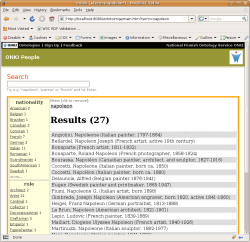ONKI People: An Ontology Service for Finding People and Organizations
ONKI People is a service for finding and disambiguating persons, groups and organizations. It is a component in the Finnish semantic web infrastructure developed in the National Semantic Web Ontology Project in Finland (FinnONTO 2003-2007).
ONKI People: ontologiapalvelu henkilöiden ja organisaatoiden hakemiseen
ONKI People on palvelu henkilöiden, ryhmien ja organisaatioiden yksilöintiin ja hakemiseen.
2011
Jussi Kurki: Toimijaontologia ja niiden käyttö semanttisessa webissä (Actor Ontologies and Their Usage on the Semantic Web. MSc Thesis, University of Helsinki, Department of Computer Science, March, 2011. bib pdf
2009
Jussi Kurki and Eero Hyvönen: Authority Control of People and Organizations on the Semantic Web. Proceedings of the International Conferences on Digital Libraries and the Semantic Web 2009 (ICSD2009), Trento, Italy, September, 2009. bib pdf
Authors and documents with identical titles are common in the digital library environment. In order to manage identities correctly, authority control is used by library and information scientists for disam- biguating and cross-referencing entity names. We argue that the benefits of traditional authority control can be enhanced by using techniques and technologies of the Semantic Web, leading to simpler management of multiple languages, better linkability of resources, simpler reuse of au- thority registries in applications, and less work in indexing. To demon- strate our propositions, we have created a prototype of an ontology server and service called ONKI People that is used in two ways: First, it is a centralized authority service providing human end-users with efficient and easy to use authority finding and disambiguation services based on faceted semantic search and visualizations. The services are available on- line also as AJAX and Web Services API for machines to use. Second, the underlying RDF triple store can be used as a content resource in ap- plications such as semantic cultural heritage portals. The paper discusses and demonstrates both use cases in a real life setting.
2008
Jussi Kurki: Finding People and Organizations on the Semantic Web. AI and Machine Consciousness - Proceedings of the 13th Finnish Artificial Intelligence Conference STeP 2008, Espoo, Finland, August 20-22, 2008. bib pdf
Finding people is essential in finding information. Librarians and information scientists have studied authority control - psychologists and sociologists social networks. In aforementioned, authors link to documents (and co-authors) creating access points to information. In latter, social paths serve as channels for rumours as well as expertise. Key problems include identification and disambiguation of individuals followed by difficulties of tracking the social connections. With semantic web, these aspects can be approached simultaneously. In this paper, we define a simple ontology for describing people and organizations. The model is based on FOAF and other existing vocabularies. We also demonstrate search and visualization tools for finding people.
Lisätietoja:
Eero Hyvönen, professori



